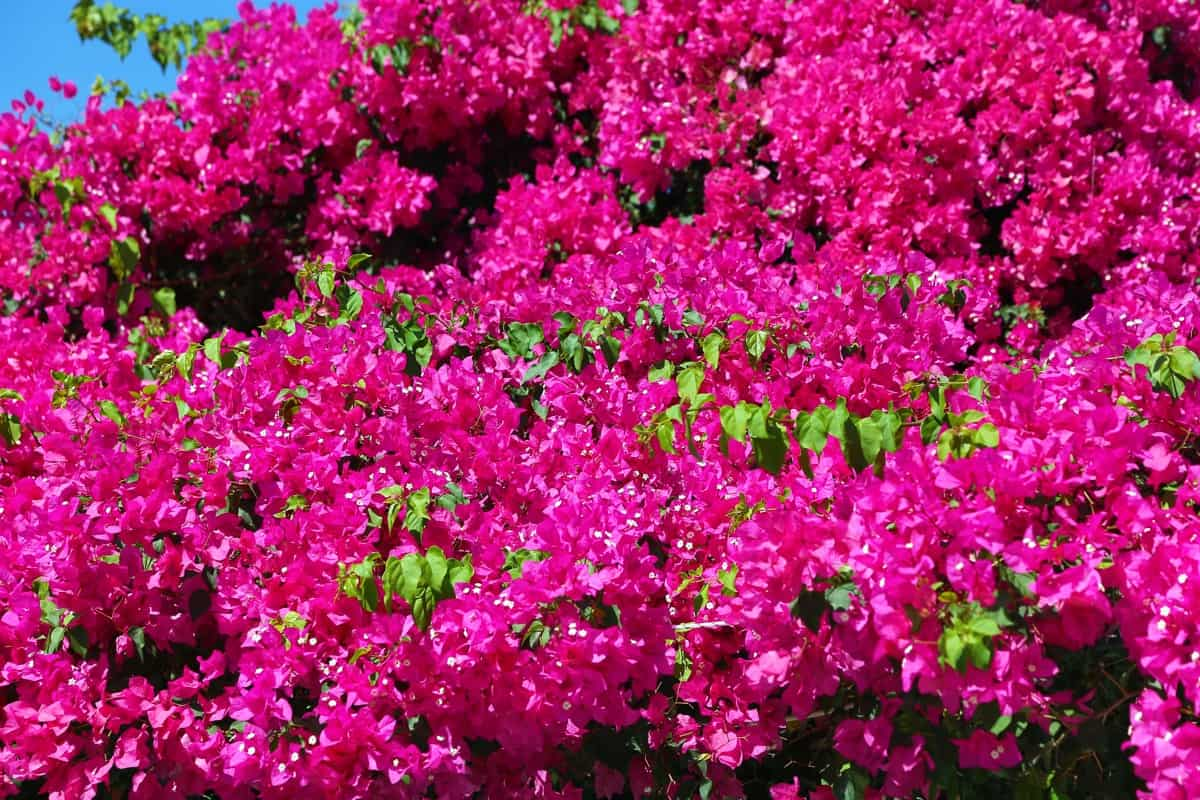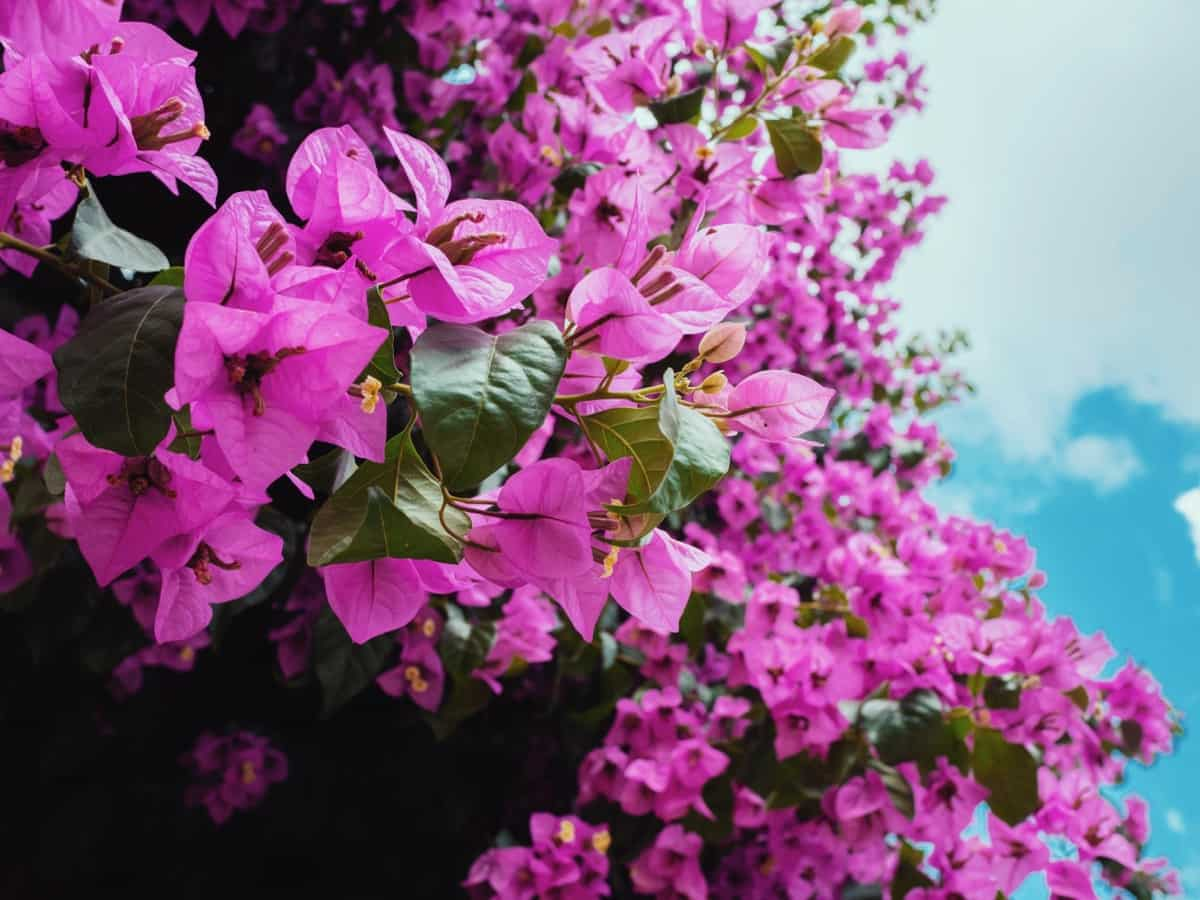Bougainvillea is a fast-growing plant that needs regular fertilization to thrive. Bougainvillea is a beautiful plant that comes in 18 different species, ranging from shrubs to vines and small trees. This plant loves warmth and sunshine all year round, making it one of the best choices for outdoor decoration. Bougainvilleas thrive well in warm climates with low humidity but not so good during rainy seasons because they tend to lose their leaves due to too much water intake. Bougainvillea is a beautiful tropical plant that can add color to any garden or landscape.

How to Make Bougainvillea Bushy
The Best Time to Fertilize Your Bougainvillea
The best time to fertilize your Bougainvillea is once in early spring before the growth spurt begins and again in mid-summer at the height of the bloom season.
Homemade Fertilizers to Make Bougainvillea Plant Bushy
- Eggshells are one of the best additions to your compost pile for Bougainvillea because they provide calcium that helps strengthen roots. Another great option is grass clippings- they break down quickly and contain lots of nitrogen, an essential plant nutrient.
- Coffee grounds are another fantastic addition as they’re acidic and add vital minerals like potassium, magnesium, and copper to the soil. Fruit and vegetable waste provides organic matter, while Epsom salt supplies magnesium sulfate required by plants when blooming.
- Grass clippings are another fantastic option for homemade fertilizer. They’re rich in nitrogen, which is perfect for promoting healthy foliage growth. Spread them around the base of your Bougainvillea once they’ve been cut.
- One of the best homemade fertilizers for Bougainvillea is banana peels. Rich in potassium, they encourage vibrant blooms while strengthening the roots. Bury them around the base of your plant or create a banana peel tea by soaking them in water overnight before using it to irrigate your plant.
- Fruit and vegetable waste also contains nutrients that can help boost your Bougainvillea’s growth.
- Epsom salt offers magnesium sulfate – vital for photosynthesis, which leads to lush foliage and abundant blooms. Mix a tablespoon of Epsom salt with about 1 gallon of water and apply it once a month during the growing season as part of your homemade fertilizer regimen.
Composting for Bougainvillea Plant Growth
- Composting is the best method to provide your Bougainvillea with all the nutrients it needs naturally and sustainably. By composting, you also reduce waste and give back to the environment.
- When starting your compost pile or bin for Bougainvillea, it’s important to include various materials such as eggshells, grass clippings, coffee grounds, fruit and vegetable waste, leaves, and wood chips. These items will decompose over time and provide essential nutrients like nitrogen and phosphorus that help promote healthy growth.
- To ensure proper aeration, you should turn compost every few weeks using a pitchfork. This will speed up the decomposition process by allowing oxygen into the pile, which helps break down the organic matter faster.
- Once your compost has reached a dark brown color with an earthy smell, it is ready to be added to your soil around the base of your Bougainvillea plant. Ensure not to add too much compost at once, which can lead to root burn. Instead, gradually increase the amount over time while monitoring your plants’ health.
In case you missed it: How to Make Rubber Plants Bushy: Best Homemade Fertilizers, Composting, and Pruning Tips

Best Guide to Making Bougainvillea Leaves Bushier
- Pruning is essential for creating bushier bougainvillea leaves. Prune the tips of each stem, which will encourage new plant growth. It’s best to prune when the plant isn’t growing during the cooler months.
- Fertilizing your Bougainvillea with nitrogen-rich fertilizer will also help create bushier foliage. You can use homemade compost as a natural source of nitrogen or purchase commercial fertilizer containing high nitrogen levels.
- Fertilization plays a critical role in ensuring maximum blooms on your Bougainvillea bush. Use a high-phosphate fertilizer during its blooming period – typically from early spring until late fall – for best results.
- Watering your Bougainvillea regularly and deeply is crucial in promoting healthy leaf growth. Watering once a week should suffice but ensure it receives enough water without causing root rot.
- Protect your Bougainvillea from pests such as spider mites and aphids using organic pest control methods like neem oil or insecticidal soap.
Pruning Tips to Maintain Bougainvillea Plant Growth
- Pruning your Bougainvillea is important to maintaining its health and promoting bushier growth. Start pruning by removing any dead, diseased, or damaged branches.
- Next, you can shape the plant by selectively pruning back long stems to encourage lateral branching, promoting a fuller appearance. Use sharp, clean pruning shears and cut at a 45-degree angle above the leaf node.
- When pruning Bougainvillea vines growing up walls or trellises, cutting them back about one-third of their length is recommended. This encourages new growth and helps keep the vine from becoming too heavy for its support structure.
- If you’re aiming for a more compact Bougainvillea shrub form instead of a climbing vine, prune away all but three to five main stems after planting and then remove any side shoots that appear on the lower two-thirds of each stem.
How Do You Increase Bougainvillea Growth?
- Bougainvillea is a beautiful and vibrant plant that can add color to any garden or landscape.
- Make sure your Bougainvillea receives plenty of sunlight. This plant thrives in direct sunlight for at least 6 hours a day, so position it in a region with plenty of sun.
- Water your plant regularly, but not to overwater the plant. While Bougainvillea plants are drought-tolerant, they require regular watering during the growing season to produce abundant blooms. Ensure that the soil around your plant remains moist but not overly wet.
- Provide ample nutrients by fertilizing the plant with compost or homemade nitrogen and phosphate fertilizers. These will help stimulate growth and create bushier foliage.
- Keep pruning dead or damaged branches regularly, as this helps promote new growth while keeping the overall shape in check.
In case you missed it: How to Make Chrysanthemums Bushy: Best Homemade Fertilizers, Composting, and Pruning Tips

Conclusion
Bougainvillea plant thrives in warm climates and requires well-drained soil with plenty of sunlight exposure. Its colorful blooms make it an excellent addition to any garden or landscape design. Due to its unique growing conditions, Bougainvillea requires specific care when it comes to fertilization, composting, and pruning techniques. Providing your Bougainvillea with proper care can ensure robust growth and maximum blooming potential.
- Feed Your Flock for Less: Top 10 Tips to Save on Chicken Feed
- Ultimate Guide to Ossabaw Island Hog: Breeding, Raising, Diet, and Care
- Hatching Answers: The Top 10 Reasons Your Chickens Aren’t Laying Eggs
- Eggs and Economics: Breaking Down the Cost of Raising Backyard Chickens
- Defend Your Greens: Proven Methods to Keep Iguanas Out of Your Garden
- Ultimate Guide to Cinnamon Queen Chicken: A Comprehensive Guide for Beginners
- Ultimate Guide to California Tan Chicken: Breeding, Raising, Diet, Egg-Production and Care
- Ultimate Guide to Marsh Daisy Chicken: Breeding, Raising, Diet, and Care
- 10 Types of Chicken Farming Businesses You Can Start for Profits